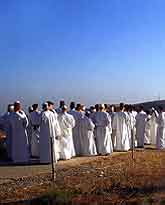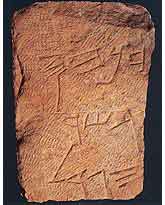The temple on Mount Gerizim
Y. Magen
Deuteronomy

“And when the Lord your God brings you into the land which you are entering to take possession of it, you shall set the blessing on Mount Gerizim and the curse on Mount Ebal. Are they not beyond the Jordan, west of the road, toward the going down of the sun, in the land of the Canaanites who live in the Arabah, over against Gilgal, beside the oak of Moreh” (Deuteronomy 11: 29-30).
This description led Rabbi Eliezer (in the Jerusalem Talmud Sotah 7:3) to state that this does not relate to Mount Gerizim and Mount Ebal in Samaria; rather the verse refers to two mounds that the Jews called Mount Gerizim and Mount Ebal, which they found in the Jordan Valley when they entered the country. In place of “against Gilgal, beside the oak of Moreh”, in the Samaritan version of these verses it is written “against Shechem”.
Rabbi Eliezer’s word’s echo the harsh theological debate that was going on between the Samaritans and the Jews, both in the Land of Israel and in the Diaspora, and particularly in Egypt, during the Hellenistic and Roman periods. The basis of the dispute about the antiquity and sanctity of Jerusalem and Mount Gerizim is a continuation of the argument about the Torah and the holy places and the end of the war and destruction of the temple on Mount Gerizim.
In 1982 archaeological excavations were begun on Mount Gerizim and have continued uninterrupted for twenty two years. The excavations at Mount Gerizim have turned up new scientific data that provided answers to numerous longstanding historical and archaeological questions since the beginning of the twentieth century.
At the crux of the dispute is Josephus’ contention that the temple on Mount Gerizim was built by Sanballat, who lived at the time of Alexander the Great, and was constructed to resemble the temple in Jerusalem.

Today we can state with certainty that the first phase of the temple on Mount Gerizim was erected in the middle of the fifth century BCE by Sanballat the Horonite, a contemporary of Ezra and Nehemiah, who lived more than one hundred years before the Sanballat that is mentioned by Josephus. Sanballat from the time of Nehemiah was probably a resident of Hawara (Horon), located at the foot of Mount Gerizim, and was a descendant of the last Israelites who remained in Samaria after the destruction of the city by the Assyrians.
Although Sanballat was the sworn enemy of Nehemiah, who returned to Judah from exile in 445 BCE, and wanted to kill him, he maintained good relations with the people in Judah and the high priesthood that served in the temple in Jerusalem.
The daughter of Sanballat married the grandson of the high priest Eliashib. This angered Nehemiah and he expelled the grandson from Jerusalem: “And one of the sons of Jehoiada, the son of Eliashib the high priest, was the son-in-law of Sanballat the Horonite therefore I chased him from me” (Nehemiah 13:28).
Sanballat the Horonite who was a pahat – governor of Samaria on behalf of the Persian Empire – decided to build a temple to a supreme god on Mount Gerizim, which was sacred to both the people of Samaria and the people of Judah, and thus severe all ties with Jerusalem and its temple.
He decided to wed his daughter to a scion of the high priesthood in Jerusalem thereby making all his descendants priests from the sect of the Jerusalem priesthood. It seems that along with the grandson of Eliashib the Priest other Judean priests came to Mount Gerizim where they built and sanctified the temple as a replica of the Jerusalem temple
It should be mentioned that the state of the priesthood and the temple in Jerusalem at this time was at its nadir as attested to by Nehemiah “I also found out that the portions of the Levites had not been given to them; so that the Levites and the singers, who did the work, had fled each to his field. So I remonstrated with the officials and said, ‘Why is the house of God forsaken’” (Nehemiah 13:10-11). The prophet Malachi, who is thought to have lived at the same time, also had harsh words about the temple and the running of it: “O priests, who despise my name….oh that there were one among you who would shut the doors, that you might not kindle fire upon my altar in vain” (Malachi 1:6-10). He later accuses them of even respecting their pahat more than the Lord. Due to the difficult conditions that prevailed in the temple it was therefore not hard for Sanballat to assemble unemployed Jewish priests in the temple on Mount Gerizim. Josephus adds that Sanballat gave them land and built homes for them. In our opinion this was the historical setting against which the temple was built on Mount Gerizim.
The Samaritan tradition sees things differently. While in Deuteronomy it says, “at the place which the Lord will choose to make his name dwell there”, in the Samaritan Torah it states “a place that was chosen at Mt Gerizim”. According to the Jewish Bible, Joshua built the altar on Mount Gerizim and not on Mount Ebal. The original temple was built on Mount Gerizim, and not according to Jewish belief, in Shiloh where Phinehas the priest served and to which where all the tribes of Israel made pilgrimage.
Prior to the death of Uzi the Priest, three events occurred: hastarat hapanim, the eternal flame was extinguished and the holy vessels disappeared from the temple, these having been hidden in a cave on Mount Gerizim. The vessels will be rediscovered when the messiah, Hathab, comes, when the End of Days will begin.
Based on the archaeological excavations, it turns out that two temples were constructed on Mount Gerizim, The first was built in the fifth century BCE and the second, a larger edifice, at the beginning of the second century BCE. A large city, populated with more than ten thousand people, rose up on 400 dunam around the temple. The residents of this city were mainly priests who strictly observed the laws regarding impurity and cleanliness, particularly the uncleanliness of gentiles, the commandment forbidding the making of graven images or likenesses. These priests fulfilled all of the laws of the Torah as they are written. The Torah was very strict regarding the purity of the temple, sometimes holding the priests accountable under penalty of death. We have no doubt that the priests who served in the temple on Mount Gerizim in the Persian or beginning of the Hellenistic period possessed the five books of Moses.
In the excavations, some four hundred thousand bones were found. These included the remains of animals that were sacrificed according to Torah procedure, among them sheep, goats and few cows and turtle-doves – a kind of pigeon for those without the means to obtain a sheep for sacrifice.
Approximately seventeen thousand gold, silver and bronze coins were also discovered in the excavations, as well as thousands of pottery, stone, copper, silver and gold vessels.
The power of the Gerizim temple in the second century BCE was no less strong than that of Jerusalem. It was sanctified by the Samaritans in Samaria and in the Diaspora, particularly in Egypt, and led to an intense conflict between Jews and Samaritans. As mentioned, it began first as a theological argument about Mount Gerizim and Mount Moriah and the holy places, and by the end of the second century BCE led to a bitter war between the Hasmoneans and Samaritans. John Hyrcanus besieged Mount Gerizim and razed the city to the ground. In every house that was excavated a thick burnt layer was discovered and many coins of John Hyrcanus and his son Yannai were recovered.
The date of the Samaritan temple destruction, the 21st of Kislev, became a holiday for the Jews during which it is forbidden to eulogize the dead.
Despite the destruction, the Samaritans continued to reside around Mount Gerizim and to sanctify it even though they were forbidden from going up onto the hill and praying there. Only in the fourth century CE, about four hundred years after the destruction of the Jerusalem temple by the Romans, did the Byzantine rulers allow the Samaritans to restore the compound but this was short-lived. In 484 CE the Byzantine emperor Zenon destroyed what remained of the compound and built a church dedicated to Maria Theotokos (the bearer of god) atop it.
Additional Articles ...